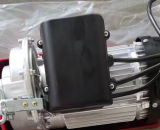


The Hand Lever Hoist A Marvel of Mechanical Advantage
Hand lever hoists are essential tools widely used in various industries, from construction to manufacturing, and even in warehouses and marine operations. They offer a practical solution for lifting heavy loads with minimal physical effort. This article delves into the design, functionality, applications, and advantages of hand lever hoists, highlighting their significance in modern-day operations.
Understanding the Mechanism
The basic design of a hand lever hoist consists of a strong metal frame, a hand lever, a ratchet mechanism, and a chain or cable for lifting. When a user pulls down on the hand lever, it engages the ratchet mechanism, which allows the chain to move upward. This mechanical advantage means that only a fraction of the load's weight needs to be exerted by the user, making it easier and safer to lift heavy objects.
The leverage principle, established by Archimedes, plays a crucial role in the effectiveness of hand lever hoists. By increasing the distance from the fulcrum (the pivot point), the required force to lift an object decreases. Therefore, operating a hand lever hoist can drastically reduce the physical exertion needed compared to manual lifting.
Versatile Applications
Hand lever hoists are incredibly versatile and can be utilized across various scenarios. Their compact size and portability make them suitable for both indoor and outdoor use. In construction, they are often employed to lift heavy materials such as beams, pipes, and machinery. The ability to make precise adjustments in height makes hand lever hoists indispensable for tasks requiring careful placement.
In manufacturing settings, these hoists can be utilized for assembly lines where heavy components need to be lifted into place. Similarly, in warehouses, they facilitate the loading and unloading of pallets and crates, streamlining the movement of goods. In the marine industry, hand lever hoists are indispensable for raising sails, docking boats, or hoisting cargo off and on ships.

Advantages of Hand Lever Hoists
One of the significant advantages of hand lever hoists is their simplicity. Unlike electric hoists, which require a power source and can be costly to operate and maintain, hand lever hoists are straightforward to use. They do not require electricity, making them reliable choices in remote locations or during power outages.
Furthermore, hand lever hoists are generally more affordable than their electric counterparts. This cost-effectiveness makes them accessible for small businesses and DIY enthusiasts, allowing a wider range of users to benefit from this innovative tool.
Safety is another reason why hand lever hoists are favored. They are designed to handle heavy loads reliably, equipped with safety features like locking mechanisms to prevent accidental release. Proper operation and regular maintenance can minimize the risk of accidents, ensuring a safer working environment.
Conclusion
In conclusion, hand lever hoists are invaluable assets in various industries, offering a combination of mechanical advantage, affordability, and ease of use. Their ability to lift heavy loads safely and efficiently makes them essential tools for professionals and hobbyists alike. As industries continue to evolve and demand innovative solutions for material handling, hand lever hoists will undoubtedly remain a relevant and significant part of the lifting equipment landscape.
Whether you're a contractor looking to streamline your operations, a manufacturer aiming to enhance production efficiency, or simply someone in need of a reliable lifting solution, the hand lever hoist stands out as a remarkable piece of equipment that harnesses the power of simple mechanics to deliver exceptional performance.



